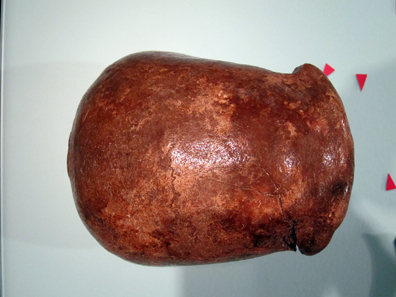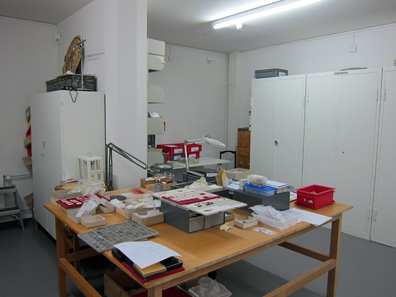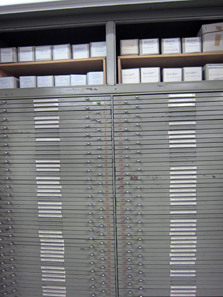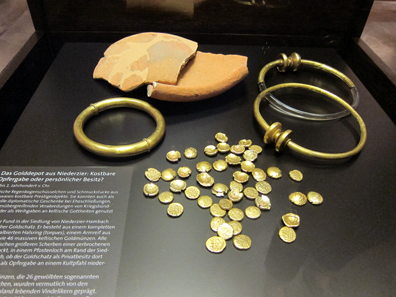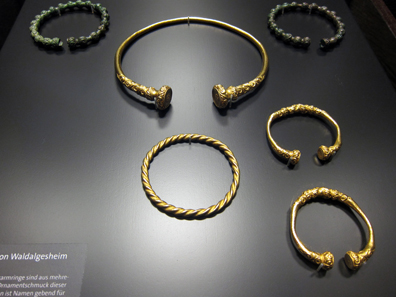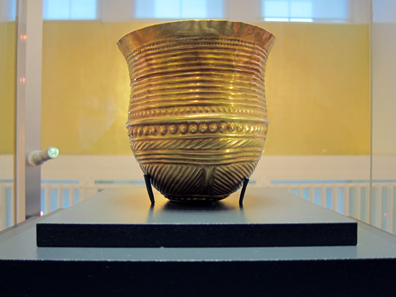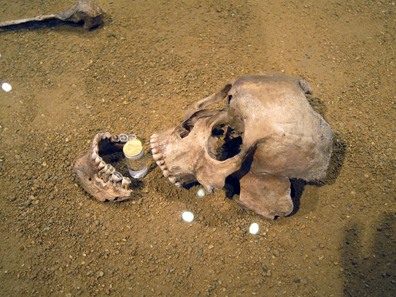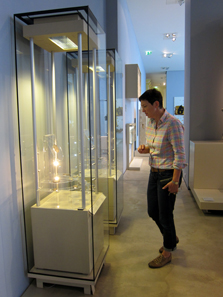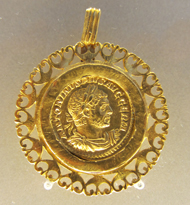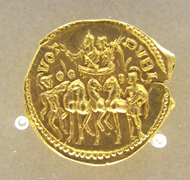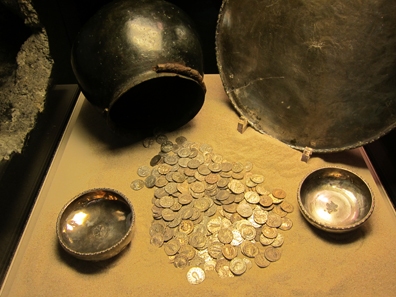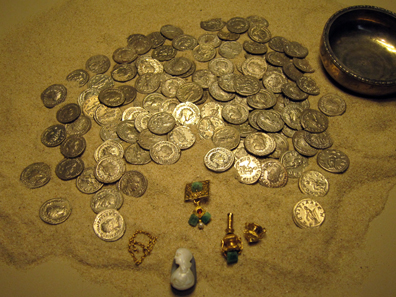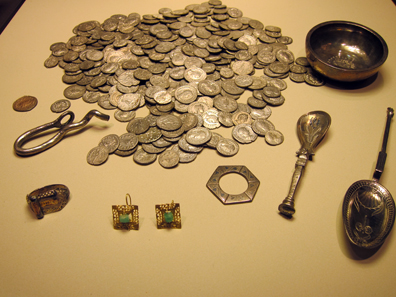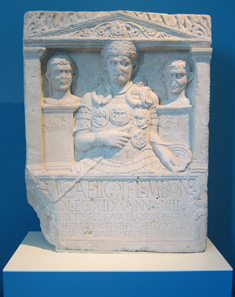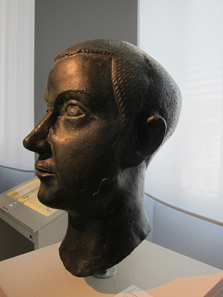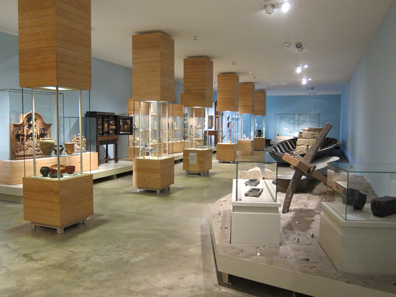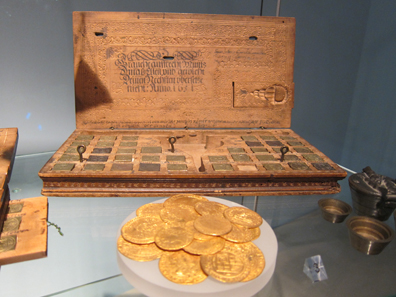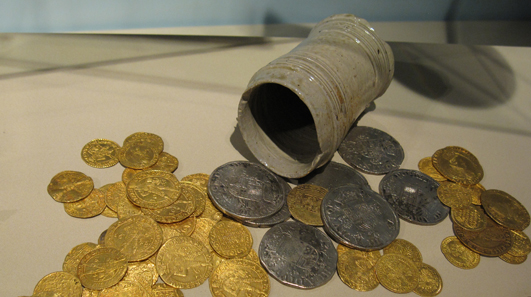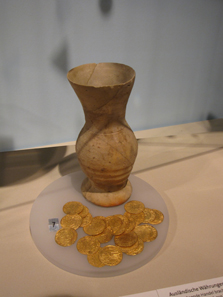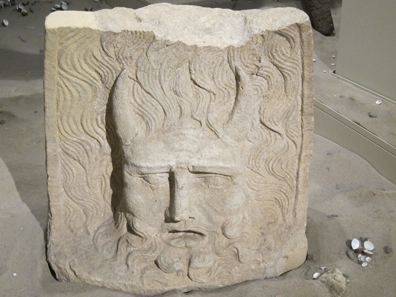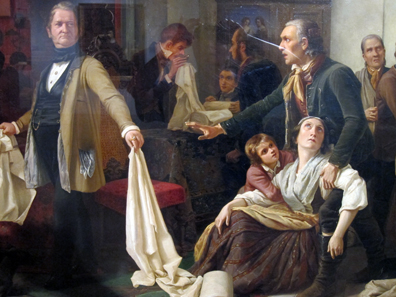by Ursula Kampmann
translated by Teresa Teklic
October 2, 2014 – Dr Claudia Klages, head of the numismatic department at the LVR-Landesmusum Bonn, has quite a lot to offer, more precisely, round about 95,000 numismatic objects: coins, scales, coin dies, medals and the biggest collection worldwide of currencies and medals minted and found in the Rhineland.
Inside the Rheinisches Landesmuseum Bonn. Photo: KW.
Don’t worry if “LVR” doesn’t tell you anything. LVR is shorthand for “Landschaftsverband Rheinland” and just indicates that the museum is a member of this regional association. What exactly the association does, I’m not sure of … Nevertheless, people simply call this museum usually Rheinisches Landesmuseum Bonn. And no matter what you call it, it is one of Germany’s oldest museums and offers several special attractions.
“Neanderthal” reconstruction. Photo: KW.
The museum’s most well-known exhibit, I assume, is the famous “Neanderthal 1” fossil, which in the 1850s led scientists to postulate the existence of a “prehistoric man”.
Skullcap of the Neanderthal skeleton. Photo: KW.
Not that this discovery would have been taken seriously by other scientists at the time. When Charles Darwin published “On the origin of species” three years after the find, the work was highly contested. Then celebrated archaeologist and physician Rudolf Virchow remained convinced until his death in 1902 that the fossil was the deformed skull of a modern man. The first to use the term Homo neanderthalensis in 1864 was an Irishman.
The coin cabinet and its curator, Dr Claudia Klages. Photo: KW.
But let’s rather leave the Neanderthal be and turn to numismatics. This is Dr Claudia Klages, who receives us in her office at the coin cabinet. Behind the door with the pictures of the famous coin type “Tanzendes Männlein” lies the sanctuary, the large, walk-in vault.
Inside the vault. Photo: KW.
The vault contains 95,000 objects, mainly find coins from the Rhineland region …
One of the safes. Photo: KW.
… some on trays and some in boxes in order to store the large quantities effectively.
One of the trays. Photo: KW.
The museum is especially well-equipped with Roman coins. Among them, rarities and significant coin hoards, but we will see more of these later when we get to the permanent exhibition.
Another tray. Photo: KW.
Of course, numismatic finds from the medieval and early modern Rhineland are featured prominently too. With regard to Rhenish coins, it is safe to say the collection in Bonn is the most significant and also the largest collection worldwide.
These private finds have been entrusted to Claudia Klages for inspection. Photo: KW.
One of the reasons why the collection is so extensive is the extremely well-functioning cooperation between Dr Klages and private finders. When we come to visit, several boxes on the table are awaiting their scientific examination. Again and again, Dr Klages tells us, that there are proud discoverers who do not just show their finds to the Landesmuseum but also donate them or sell them for a very decent price considerably below market value.
But let’s take a look at the permanent exhibition, which contains an unusually high number of coins and medals. A pleasure for all coin collectors. And if you keep your eyes open, you’ll spot many more objects that are of relevance for economic history.
Niederzier gold depot. Photo: KW.
Let’s start with the new exhibition on the Celts, which grants visitors access to the museum’s incredible treasures since June 2014. Part of the exhibition is for instance the depot found in Niederzier, consisting of one armlet, two torques and 47 Bavarian gold coin, called “rainbow cup” coins (= Regenbogenschüsselchen).
Jewellery from the princely tomb of Waldalgesheim. Photo: KW.
The numismatic relevance of the jewellery from the wagon burial of Waldalgesheim is not obvious at first glance.
Blown-up end piece of one of the torques. Photo: KW.
Clever researchers made some calculations and found out that the weight of the sophisticatedly manufactured rings can beautifully be divided by the weight of Macedonian and Persian coins. It is assumed that either gold staters of Philipp II or Persian darics were melted down to produce this lavish jewellery.
Gold cup, found in Fritzdorf. Photo: KW.
This famous gold cup does not stem from the Celtic era but from the Bronze Age. It was found in the mid-20th century in Fritzdorf by a farmer setting up a beet clamp and is impressive proof of the trade already existent in the Bronze Age. Similar cups, modelled in the Cretan-Mycenaean style, were found in South England and Switzerland.
The Eschenz Gold Cup cannot be viewed in Bonn but in Frauenfeld, Switzerland.
Photo: KW.
Many a scientist today would like to believe that the Eschenz gold cup, for all its dots, was used as a calendar, amongst others.
Grave of the Lord of Morken. Photo: KW.
But back to the Landesmuseum Bonn. On the intermediate storey, we discover a central find from the time around 600. The contents of the grave of the Lord of Morken. Some of the objects on display have travelled a long way. They come from England or Scandinavia, from Italy, China …
Charon’s obol in the mouth of Mr von Morken. Photo. KW.
… and from Byzantium as the trained numismatic’s eye will immediately recognize on looking more closely at the Charon’s obol in the mouth of the dead.
Looking at the large number of coins and medals she was able to integrate into the permanent exhibition, Claudia Klages has every right to be proud. Photo: KW.
One of the rooms in the permanent exhibition even has a number of cabinets exclusively filled with numismatic objects. Among them are a few real gems:
Aureus of Caracalla in ancient setting. Photo: KW.
This Caracalla aureus in ancient setting …
Aureus of Postumus. Photo: KW.
… an incredibly rare aureus of Postumus, depicting a largitio scene, and …
Siege money. Photo: KW.
… several klippes, siege money minted during the siege of Cologne and Jülich.
The coin hoard of Niederbieber. Photo: KW.
The Roman collection offers further coins, among them the coin hoard of Niederbieber. It is numismatic evidence of the castellum’s destruction by the Franks in 260: of the 889 antoniniani, not a single one has been minted after 258.
Niederbieber coin hoard II. Photo: KW.
A second hoard of coins, buried roughly at the same time as the first, was discovered near the principia (military headquarters) in Niederbieber, the place where you could find not only the commanding officer but also where the standards and the soldier’s funds were kept. The last coins from this find also date back to 258.
Temple hoard from Xanten. Photo: KW.
Just next to it, a hoard that was found in the Temple of the Matronae is on display. The coins alone weigh more than four Roman pounds, so taken together around 1,385 g.
Altar of the matronae, erected in AD 164. Photo: KW.
In case you’ve never heard of the matronae before – as I had – you will meet them at the Rheinisches Landesmuseum. The matronae were female deities, worshipped predominantly in Gallo-Roman culture. Evidence of this cult are votive stele and altars dedicated to the matronae; more than 800 of these have been found in the Province Germania Inferior alone. And a good part of these finds are now stored safe and sound at the Rheinisches Landesmuseum Bonn.
By the way, you can recognise these divine ladies relatively easily by their melon-shaped hairdos and the fact that they are always represented in a threesome.
Marcus Caelius, killed in the Battle of the Teutoburg Forest. Photo: KW.
The “Rome” section has many more fascinating objects to offer. Let’s focus on two pieces. The cenotaph of Marcus Caelius is famous for being the only epigraphic evidence of the Battle of the Teutoburg Forest. The historically immensely important inscription reads (in translation): For Marcus Caelius, son of Titus, from the Lemonia tribe, from Bonn. First rank centurion of the 18th legion. 53 and a half years old. Killed in the War of Varus. Mortal remains may be buried here. Publius Caelius, son of Titus, from the Lemonia tribe, his brother, made (the tombstone).
Bronze portrait of Gordian III. Photo: KW.
For the numismatic fan, this exceedingly rare bronze head of Gordian III is also worth seeing. It shows that the young Roman looked just as weird in reality as he did on his coins.
The theme of this room is the economy in the Rhineland. Photo: KW.
If you haven’t seen enough yet: here’s an entire hall dedicated to the economy in the Rhineland.
Scale. Photo: KW.
It houses some examples of products manufactured by the scale industry located in the Rhineland.
Kestenich hoard from the 17th century. Photo: KW.
And of course there are numerous coin hoards, like the one from Kestenich, buried in the 17th century …
Weiler coin find, mid-15th century. Photo: KW.
… or the Weiler hoard from the middle of the 15th century.
Rhenus Bicornus. Photo: KW.
A special treat for the numismatic connoisseur familiar with the coinage of the Gallic Empire is this Rhenus Bicornus, which immediately renders obvious why coin descriptions often speak of the “horned Rhine”.
Silesian weavers. Painting by Carl Wilhelm Hübner, 1844. Photo: KW.
Let’s end our little tour through the Rheinisches Landesmuseum Bonn with a look at a painting in which Carl Wilhelm Hübner captured the suffering of the weavers in Silesia. Newspapers were publishing detailed reports on the misery of the concerned in 1843 and, like many intellectuals, the painter took up this theme in his work. Heinrich Heine was still to write his famous “Weberlied” and Carl Wilhelm Hübner expressed a critical stance in his painting in the factory owner’s defensive posture towards the luxury surrounding him.
You see, there is much to discover for those interested in numismatics and economic history at the Rheinisches Landesmuseum Bonn. We warmly recommend a visit!
More about the Rheinisches Landesmuseum here (in German).
YouTube features this short film (lots of pictures, but in German only and not terribly exciting) about the exhibtion.
Should you decide to visit the Landesmuseum, don’t hesitate to stop at the in-house Restaurant Delikart should you want any refreshments. It will teach you better than to think all restaurants at museums are no good.
If you’re already in Bonn, why not also pay a visit to the Haus der Deutschen Geschichte? The museum, which is one of the most highly frequented museums in Germany, does not only tell the history of Germany. And it holds one or two interesting stories about Germany’s monetary and economic past.







